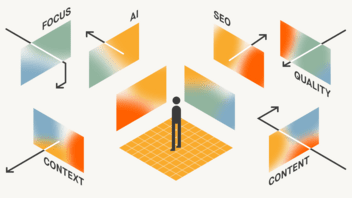How pillar content structures your content logically, improves the user experience, and boosts your SEO performance.
Pillar Pages: How to increase your traffic with pillar content
In a nutshell: Pillar pages
- Pillar pages are central pages that comprehensively present a topic and link to in-depth articles
- Logical structure with a main page (pillar content) and supplementary content (cluster content)
- Enhanced visibility in search engines through a semantic network
- Clear design with subheadings and a clickable table of contents
- Meaningful internal linking within the cluster – without creating silos
What is a pillar page?
A pillar page is a central, in-depth page that covers a broad topic in a clear, structured way while linking to related content. It serves as the hub, connecting the main topic (pillar content) with detailed subtopics (cluster content).
The pillar content concept is based on organizing website topics into a semantically logical network – bringing together main pages and supplementary articles – to create a stronger, more cohesive content structure.
Pillar pages serve as a central reference point, providing a broad overview of a topic while detailed articles dive into specific aspects. This enhances both user accessibility and search engine understanding.
Holistic isn’t always holistic
The pillar page approach emphasizes treating a topic holistically – meaning comprehensively and in depth. However, 'holistic' doesn’t always mean the same thing – two different approaches are often confused here. It is important to be aware of these differences when defining a pillar page.
Traditional holistic content in SEO aims to present a topic exhaustively on a single, all-encompassing page. All details and aspects are bundled together to create a comprehensive source of information.
The pillar content approach is different: Instead of cramming everything onto one page, the topic is divided into clearly structured sections. A pillar page serves as the central hub, providing an overview, while specialized subpages (cluster content pages) explore individual aspects in detail.
Why does this difference matter? Our experience shows that the pillar content strategy is often more effective. A single, excessively long page can be overwhelming – both for users seeking specific answers and for search engines trying to assess individual topics.
The pillar content structure, on the other hand, provides clarity: The pillar page remains concise, guiding users to relevant subpages where specialized topics are covered in depth. It also serves as a hub for internal linking, distributing link authority ('link juice') to its connected pages.
For us, 'holistic' does not mean bundling everything on one page. Rather, it stands for a well thought-out, networked structure that improves both the user experience and SEO performance. Content can be specifically optimized and displayed for different search intentions. Holistic means here: Holistically organized, not overloaded.
Our tip for everyday SEO: The term 'holistic' is often thrown around as a buzzword to make strategies sound more impressive – unfortunately, often with little real substance. So next time, be sure to ask directly what exactly is meant. Because one thing is clear: the term alone will not magically improve your rankings.
Want real results instead of buzzwords? We use data-driven content strategies to increase your visibility.
Pillar page vs. landing page
Pillar pages and landing pages serve different purposes and are structured accordingly.
Pillar pages function as thematic hubs. The pillar content provides a broad overview of a topic and links to related subpages. The goal is to introduce users to the topic and direct them to in-depth information.
Landing pages, on the other hand, focus on conversions. They are designed to drive a specific action – whether filling out a form, purchasing a product, or downloading a resource. Unlike pillar content, landing pages prioritize clear, action-driven messaging over thematic networking.
In short: Pillar pages provide thematic orientation, while landing pages focus on conversion.
Why pillar content is a smart content marketing strategy
Search engines stopped relying on simple keyword matching long ago. With the launch of Google Hummingbird in 2013, semantic search sparked a major shift. Instead of just recognizing a string of keywords, Google began analyzing search queries as complex, contextual questions. Since then, the focus has been on understanding user intent and uncovering the deeper meaning behind searches.
Later advancements, like BERT (Bidirectional Encoder Representations from Transformers), have taken this even further. BERT leverages machine learning and neural networks to understand words in context – both forwards and backwards. This helps Google grasp subtle details, like prepositional relationships and syntax nuances. The result? Search engines don’t just recognize what users are searching for – they understand why.
This is exactly where pillar content comes in: A pillar page acts as the central hub, with its topic cluster expanding on key subtopics – creating a semantic network that helps Google understand content in a more connected way. This structure signals to Google that the content is interrelated and collectively provides a comprehensive view of the topic.
Modern search algorithms no longer evaluate pages in isolation – they assess content within the context of an entire topic cluster. By aligning with this semantic logic, pillar content is seen as more relevant and authoritative in search rankings.
Pillar Pages in the context of E-E-A-T
E-E-A-T (Experience, Expertise, Authoritativeness, and Trustworthiness) is a key framework Google uses to assess content quality. The goal is to deliver content that demonstrates strong subject matter expertise (Expertise), is created by credible and authoritative sources (Authoritativeness), and is backed by real-world experience (Experience) and a proven reputation for reliability (Trustworthiness).
Pillar content helps you meet these standards by presenting topics in a comprehensive, well-structured way – both in breadth and depth. By strategically linking to cluster content, you strengthen your content ecosystem, ensuring all relevant aspects are logically connected. In this way, you build sustainable thematic authority.
And a heads-up: E-E-A-T is becoming even more important in the context of AI search engines such as ChatGPT, Perplexity, or Google's AI Overviews.
Is your content AI-ready? Future-proof your content strategy with our expertise.
Search engine friendly + user friendly = the perfect match
Google has long claimed that user signals don’t directly affect rankings. However, a legal case in the U.S. revealed what many SEOs had suspected all along – user behavior does play a role. How people interact with your site influences Google’s evaluation of your content and ultimately impacts your ranking.
This is where the pillar content approach comes in. A well-structured pillar page makes your content clear, easy to navigate, and helps users quickly find what they need – keeping them on your site longer. As they click through linked cluster pages and explore related topics, they signal to Google: "This content is useful, relevant, and exactly what I was looking for."
Pillar content bridges the gap between SEO and user experience. If your content works for users, it works for Google, too. The result? Higher rankings, more traffic, and satisfied visitors who keep coming back.
Structure & examples: Pillar pages in practice
In content marketing, different terms are used to describe various pillar page types. One of the most frequently mentioned is the 10x pillar page – a concept likely originating from an older MOZ blog post. It suggests that this type of pillar page is ten times more valuable than standard content in terms of traffic and engagement.
Other frequently mentioned variants are the How-To-Pillar Page, the "What is ...?" Pillar Page, or the Resource Pillar Page, which integrates relevant external resources on a topic in addition to its own content.
But rather than overwhelming you with theoretical classifications, we’d rather show you how pillar pages work in real-world applications. Based on our project experience, we’ll demonstrate how pillar pages can be structured in different ways – tailored to specific goals, topics, and user needs.
Guide pillar: Broad knowledge with depth of content
For our client ThermaCare, we created a comprehensive pillar page on back pain. This page provides users with a detailed overview and serves as an informative entry point into the topic. It covers key areas such as causes, symptoms, and initial relief tips in a clear and structured way. At the same time, targeted links lead to specific cluster pages, for example on certain symptoms or effective exercises, which provide more in-depth insights.
Classic hub page: Overview and structure
A classic hub page can also function as an effective pillar page when built with the right strategy. A great example is the lawn care hub page we developed for our client STIHL. While it provides a brief introduction to the topic, its primary purpose is to guide users to in-depth subpages within the topic cluster.
To enhance user experience, the subpages are logically grouped into clusters, covering topics such as 'Mowing the lawn' and 'Improving the soil.' These clusters are reinforced with clear anchor links, making it easy for users to navigate directly to the content most relevant to them.
Integrated inspiration: Incorporate cluster content organically
For our client Hama, we developed a pillar page that approaches a specific topic in a creative and engaging way: Smart Home ideas. This page showcases 15 DIY ideas designed to inspire users – for example, using Alexa as a baby monitor or setting up a smart notification system for mailbox deliveries. However, for topics with a correspondingly high search volume, we have created additional, detailed articles that are linked directly from the pillar page.
Create a pillar page: Step by step
Creating a pillar page requires a clear strategy, structured approach, and content that is optimized for both users and search engines. Follow this step-by-step guide to successfully plan and implement your own pillar page.
Step 1: Choose the main topic
Select an overarching theme that:
- Is highly relevant to your target audience
- Is broad enough to encompass several subtopics
- Aligns with your business or marketing objectives
Step 2: Conduct keyword research and topic clustering
Analyze your main topic and break it down into specific subtopics that can serve as cluster content. Ask yourself:
- What questions or challenges do users face in this area?
- How can the subtopics be structured logically?
To find relevant topics, use tools such as:
- Google Keyword Planner
- AnswerThePublic
- Ubersuggest
- PeopleAsked
- TopicLoops
AI tools like ChatGPT or Microsoft Copilot can also help with initial research. Once you’ve gathered ideas, verify their SEO relevance using a keyword tool. For more details on finding the right topics, check out our article Content planning: Creating an editorial plan.
Step 3: Create your pillar page
Your pillar page should provide a clear overview of the topic and guide users seamlessly through its various aspects. We’ll use our own pillar page on the topic of Content Experience as an example.
We start by defining what content experience means and why it’s important in content marketing. Then, we explore its connections to brand experience and customer experience, highlight the key elements of a great content experience, and share best practices. This structured approach provides users with a solid foundation on the topic.
For those looking for more in-depth information, we include teasers linking to related articles, such as: Creating a content strategy, Performing a content audit, or what AI means for the future of content marketing.
To enhance navigation, we organize content into three clear clusters: Content Strategy, Performance Measurement, and Governance. Additionally, a clickable table of contents with anchor links ensures users can quickly jump to relevant sections.
Step 4: Create cluster content and link effectively
Now it’s time to create your cluster content – each page fully optimized for search engines, ideally based on a clear SEO briefing. Meaningful internal linking is important. Each cluster page should be prominently linked from your pillar page, allowing users to easily access more detailed information. At the same time, cluster pages should also link to each other where relevant.
For example, within our 'Content experience' cluster, we link the Content audit article within our Content strategy page – because these topics are closely connected. A well-structured, interlinked cluster helps cover the topic holistically, improving both user experience and search engine visibility.
But beware of content silos! Many SEO agencies still recommend only linking within a cluster, but we see it differently. Content should be linked wherever it makes sense for the user. For example, on our 'Content experience' pillar page, we also link to the Barrier-free web design article – even though it belongs to a different cluster – because the connection is relevant and provides added value for users.
Step 5: Track performance and optimize continuously
Your work on a pillar page doesn’t end once it’s published. Effective performance tracking helps you measure whether your pillar content is achieving its intended goals and contributing to your KPIs. Regularly analyze how your pillar page is performing and make data-driven adjustments when needed.
Step 6: Expand your topic clusters over time
One of the biggest advantages of the pillar content approach is its scalability. You can continuously add new cluster pages to cover additional aspects of the topic or respond to emerging trends – without disrupting the existing structure.
For this strategy to work long-term, your semantic information architecture should be designed with flexibility in mind from the start. Plan your pillar page so it remains adaptable and easy to expand with fresh content.
Every new cluster page strengthens your topical authority, signaling to search engines that your site covers the subject comprehensively and stays up to date.
Is your pillar content struggling to rank? We can help you unlock its full potential.
Pillar page: Best practices
Clear structure and subheadings
Break your content into well-defined sections with concise, meaningful subheadings. This makes it easier for users to scan and understand the content while helping search engines recognize key topics at a glance.
Table of contents with anchor links
Include a clickable table of contents with links so users can quickly jump to the sections most relevant to them.
Strategic internal linking
Connect your pillar page to its cluster content in a logical, user-friendly way. This creates a well-structured topic network that helps Google understand your content’s depth and relevance. However, avoid content silos – link across clusters when it improves user experience.
Pillar page design
Use a clean, structured layout that prioritizes readability and intuitive navigation. A clear visual hierarchy helps users find key information quickly. Ensure that your website aligns with industry standards and is designed to meet accessibility guidelines.
SEO and performance optimization
Optimize both your pillar page and cluster content with relevant keywords, including primary, secondary, and semantic variations. Focus on search intent rather than keyword density. Regularly track performance metrics and make data-driven optimizations.
Important questions and answers
-
A pillar page is a central, comprehensive page that presents a large topic clearly and is linked to detailed subpages (cluster content). It serves as a point of orientation for users and search engines by organizing a topic holistically and providing in-depth information.
-
- Use a clear design with subheadings and a table of contents with jump labels.
- Link relevant cluster pages logically and avoid silos.
- Optimize the content for SEO and update it regularly.
- Keep the design intuitive and user-friendly to ensure a positive user experience.
-
Pillar Content creates a semantic network of main and cluster pages that helps both users and search engines to better understand content. This improves the user experience and increases the relevance of your content in search engines.
-
No. A pillar page provides a comprehensive overview of a topic and links to more in-depth content, while a landing page is optimized for a specific conversion such as sales, downloads, registrations or contacts.
Does that sound interesting? Arrange an initial consultation.
Thank you!
We’ll get back to you as soon as possible.










